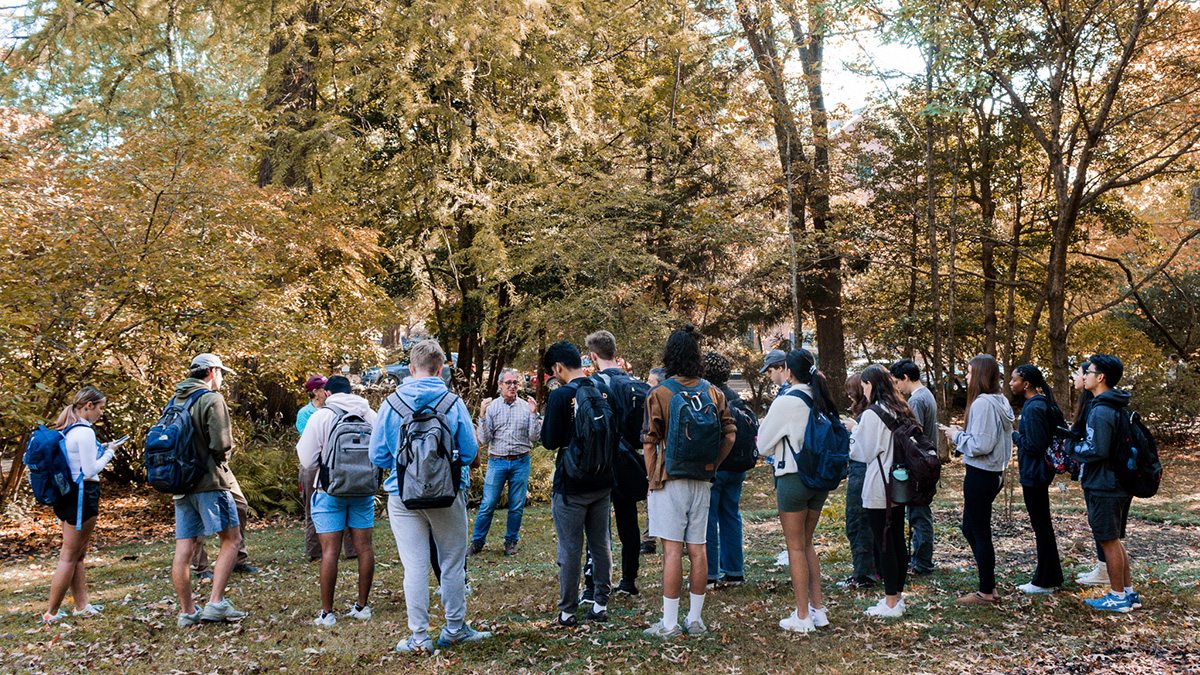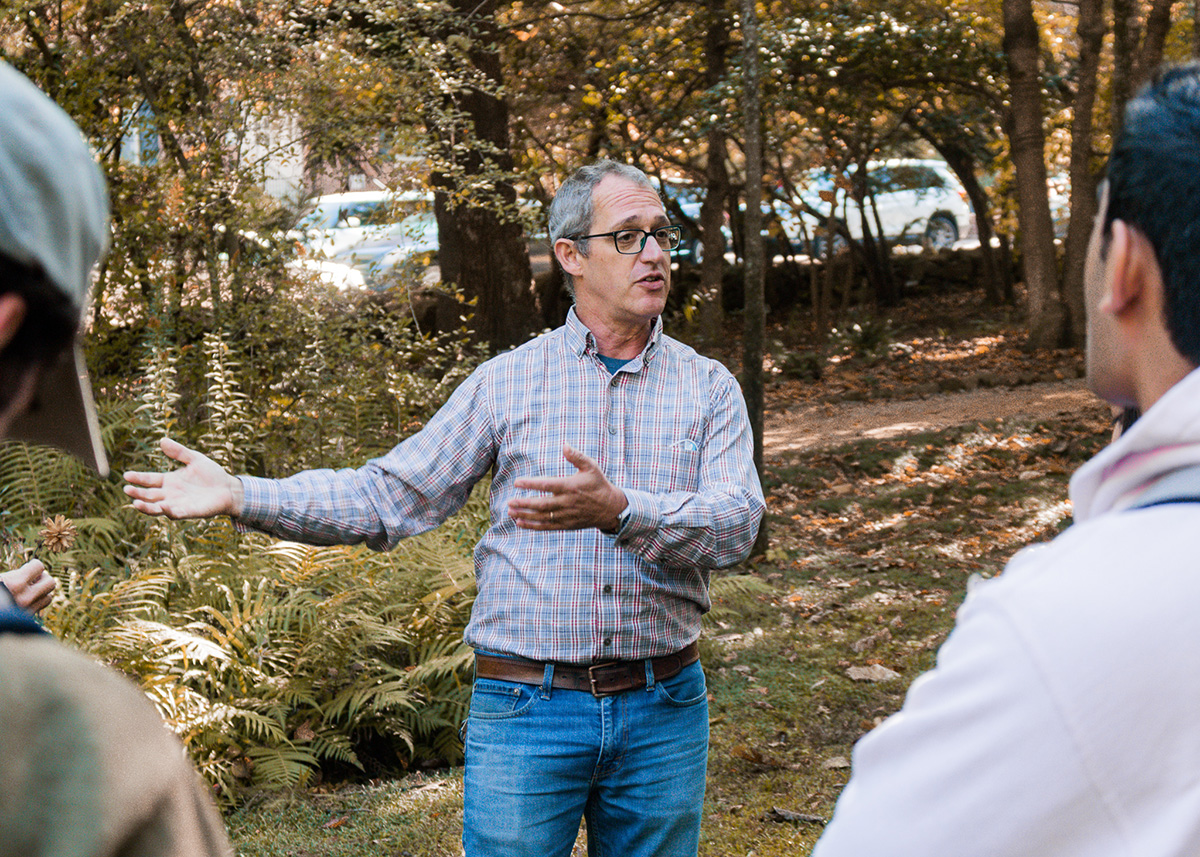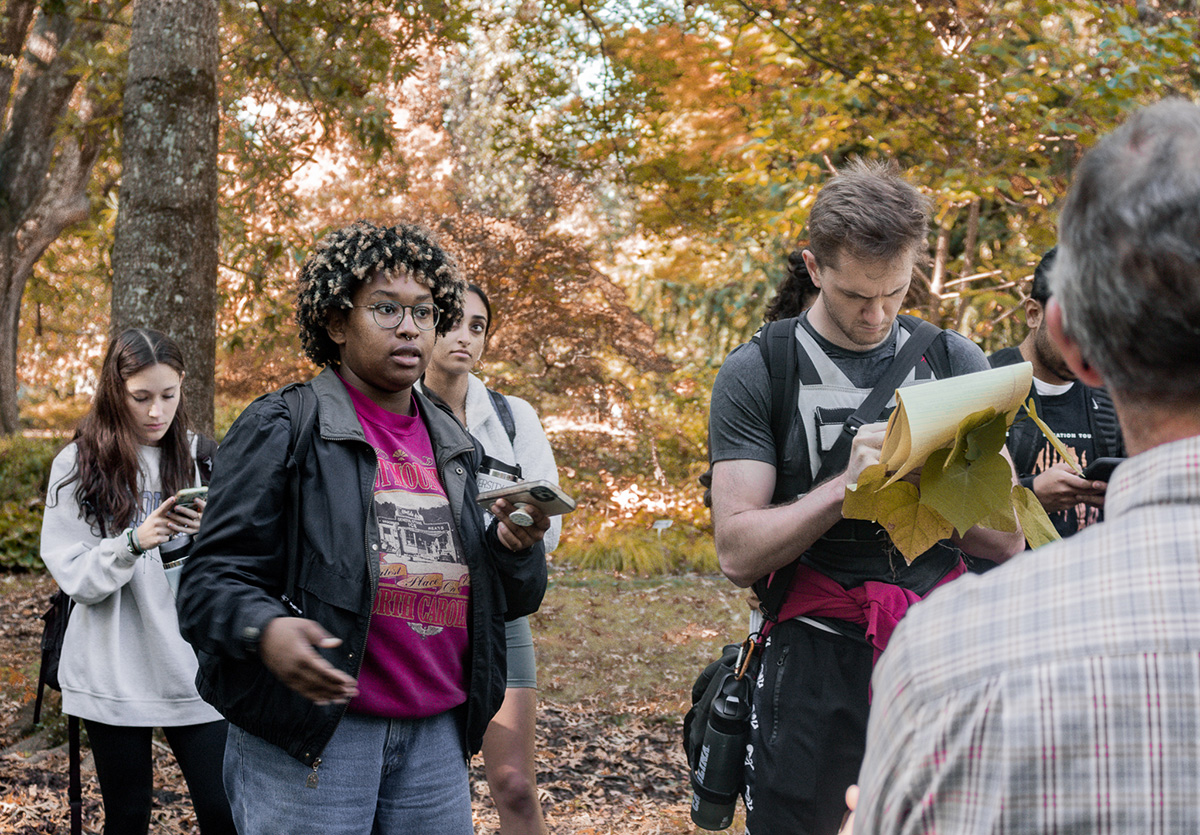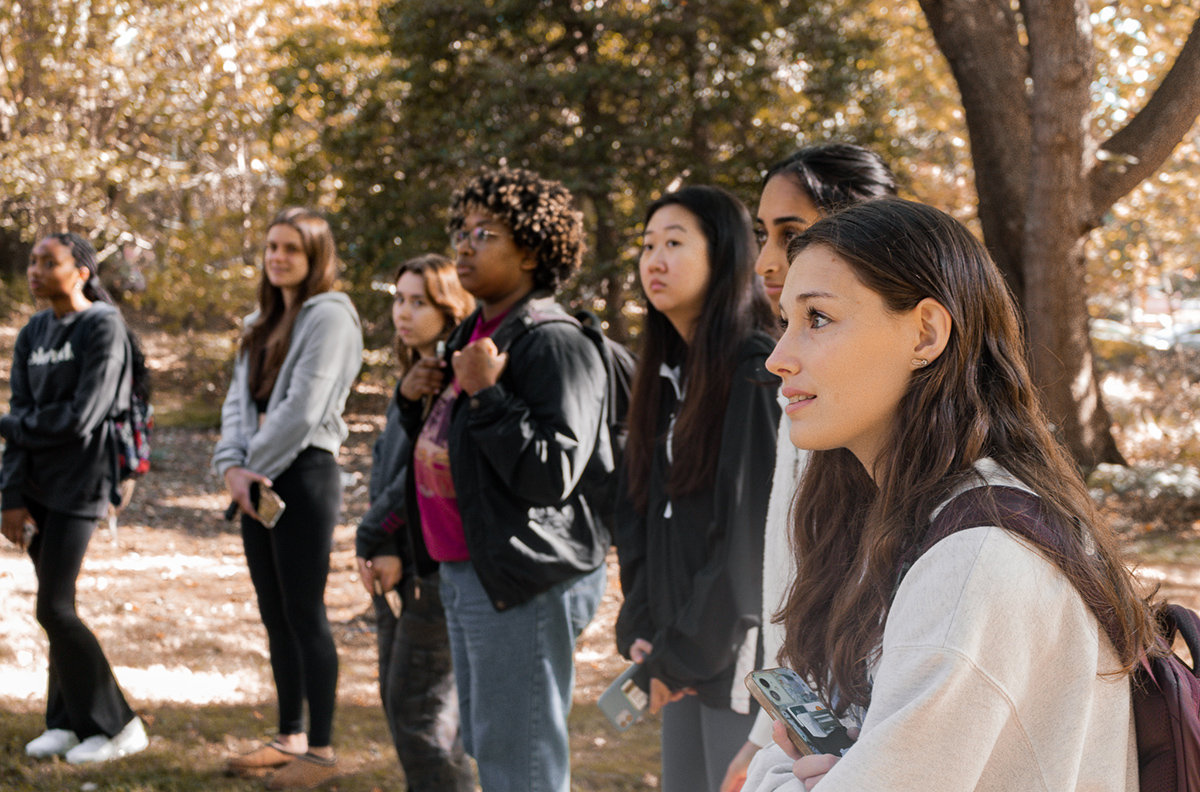Plants meet prose in this Carolina English class
Carolina professor Marc Cohen works to make his assignments immersive and experiential, including the course’s most recent collaborative unit on non-native, invasive plants with the North Carolina Botanical Garden.

Under the golden light of a cool Wednesday morning, a group of Carolina students follows the Sourwood Trail Loop in Carolina’s Battle Park.
They walk closely behind Ben Heuser, natural areas steward at the North Carolina Botanical Garden, who stops occasionally to eye the flora around him, walk off the footpath and pluck vines and saplings for closer observation.
Heuser is specifically looking for non-native, invasive species — plants that would not naturally call the Southeast home but have ended up in the area through human intervention.
The students pull out their notebooks and phones to jot down details of the invasive plants that Heuser notes, recording both their common and scientific names. They pause to listen to the soft thumps of acorns falling from the trees onto the leaves below their feet.
Passersby would be forgiven for thinking this class studied botany or ecology or environmental science.
But these students are on the trails as part of English 105, an introductory writing and rhetoric course taken by all first-year and transfer students at UNC.

Daniel Stern, director of horticulture at North Carolina Botanical Garden, stops the class in Coker Arboretum to observe the native plants. (Photo by Jess Abel)
Marc Cohen, teaching associate professor of English and comparative literature in the College of Arts and Sciences, teaches this English 105 class and is responsible for the innovative curriculum.
For this unit, Cohen teamed up with Daniel Stern, director of horticulture at the North Carolina Botanical Garden, which is part of Carolina. Stern, with the help of Botanical Garden experts, including Heuser, gave students an immersive, experiential week of learning about non-native, invasive species in North Carolina through walking tours of three of the many outdoor spaces the Botanical Garden manages.
The goal: For students to write a narrative, informative story about non-native, invasive plants based on the information they learn while on the outdoor tours. They’ll do so by emulating the vibrant storytelling of Brooke Jarvis, an award-winning journalist they are studying.
Creative curricula
“Designing units is very much an act of creativity for me,” Cohen said. He began creating experiential units in his introductory English classes in 2016, beginning with a collaboration with Carolina Performing Arts.
Since then, he has worked with many campus units, including PlayMakers Repertory Company, the libraries’ Southern Historical Collection and the athletics department. Students have written stories with inspiration from rapper Tierra Whack, the championship-dominating Carolina field hockey team and the legacy of Andy Griffith.
Cohen’s first step in designing a collaborative curriculum? Often, a cold email.
When that email landed in Stern’s inbox in the summer of 2021, the start of a long collaboration with the Botanical Garden began.
“Dan [Stern] responded positively, and almost immediately,” said Cohen, noting that this is the third semester that he and Stern have co-taught the non-native plant unit. “And he’s been enthusiastically renewing each time, which I’m so grateful for.”

Students asked detailed questions about the arboretum’s plants to gain insight for an assignment they are writing for Cohen’s English class. (Photo by Jess Abel)
This semester, the unit began on a Monday morning in Cohen’s classroom in Caldwell Hall. Students gathered around a boardroom-style table as Stern shared the history of the Botanical Garden, which manages 1,200 acres of land in and around Chapel Hill. He also gave an overview of non-native invasive plants.
For some students, the topic was familiar. Kudzu, an invasive species from Asia that is known for “swallowing the South” was part of Stern’s presentation. Carlisle Shore, a first-year global studies major, remembered hearing about the plant before the class.
“But I didn’t know about any of the species that we talked about” on the tours, she said.
In the gardens
The tours — one of Battle Park’s trails and one of Coker Arboretum, a 119-year-old garden not far from the Old Well — took place over the next two class periods on Wednesday and Friday, with an optional trip to the Botanical Garden on Sunday.
The classes were as different as they were immersive.
In Battle Park, Heuser passed non-native plants, including English ivy and Winter Creeper, from student to student so the class could make detailed observations for their upcoming assignment. Cohen noted the bordering residential streets and encouraged students to write characters into their story based on who might live in the houses near the park.
“It was such a unique experience,” said Nya Lowe, a first-year psychology major who attended all three tours. It was the first time she had a class introduce a topic in such an experiential way.
“I’m a visual learner,” she said, “so to be out there and kind of, like, immersing myself is very helpful.”
On Friday, the students filed into Coker Arboretum on the corner of Raleigh Street and Cameron Avenue. They walked under the arbor, a covered walkway constructed with black locust logs which, normally, boasts sprawling vines that bloom May to July.
Today, the logs are bare. The Botanical Garden staff is preparing to refurbish the structure for the first time since 1997.
This story, too, is tied back to invasive species, the class learned. The purple-flowering Chinese wisteria that was chosen to cover the arbor when it was first constructed was not native to the Southeast but flourished in the climate. Seeds from the flowers dispersed south to Battle Park.
Now, in the spring, swaths of wisteria grow over the park’s tallest trees. The vines threaten to choke the trees of sunlight, and the wisteria’s roots can dig into the trunks of the trees themselves, making it very difficult to eradicate the invasive plant.
“We were working against ourselves,” Stern said.
As the class took copious notes, Stern detailed the work horticulturists at the Botanical Garden did to replace the non-native, invasive vine with native ones, such as native wisteria, coral honeysuckle and Carolina jessamine, both to show the beauty of native North Carolina flora and to sustainably plant in the gardens they manage. The students bounced questions back and forth, applying what they learned in class with the questions the arbor story prompted about their own upcoming writing assignment.
“I think my paper would be very different if I did not have this experience,” said Gerard Millman, a transfer student from Ferndale, Washington, who is studying journalism through the Hussman School of Journalism and Media.
“If I were to just research this stuff online or in the library, I would really be limited in my understanding of what the deeper connections are to everything,” Millman continued. “And I would lose out on my experience of trying to convey that newfound expertise in my paper for other people to both be entertained by and educated from.”
Stern is always deeply moved by the depth of understanding the students gain from their time in the gardens. The first unit he taught with Cohen was in spring 2021. The stories he read from that class were profound.
“I think of that first class — there was a lot of COVID-19 in their essays and a lot of their own reflections on what being in nature suddenly meant to them because of being isolated or quarantined. That was really powerful.”

Cohen’s students gained insight about and appreciation for Carolina’s green spaces, along with new intel about non-native, invasive plants, in this collaborative unit. (Photo by Jess Abel)
Along with a deeper understanding of the gardens and the non-native, invasive plants around the Southeast, Stern hopes students leave the collaborative unit with a new-found appreciation for the natural beauty of their campus.
“I hope they walk away with an awareness about the green spaces that they have access to here and an appreciation of a sense of place,” he said.
Cohen agreed, saying that being in the gardens was transformative, both for his students’ campus experiences and for their learning objectives.
“Developing your writing is painstaking work,” he said. “If you’re not used to receiving criticism on your writing, it can be a little painful sometimes. And these kinds of creative units make doing that easier.”
Cohen and Stern encourage faculty members to reach out to colleagues across disciplines to partner in developing more of these kinds of creative units.
“Read university publications, network at university events and participate in university service with an eye toward cross-campus collaboration,” Cohen said, noting that this is how he gets many of his initial ideas.
“And don’t be afraid to write a cold email to a university colleague whom you’ve never met,” he added. “The vast majority of our colleagues to whom I have reached out have responded with enthusiastic interest.”




